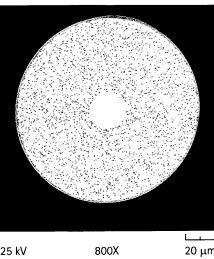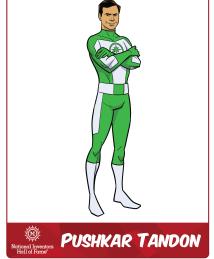Pushkar Tandon
"Always do your best and do the right thing when nobody is watching. When you are doing the right thing, you are giving your best. If you start worrying too much about the results, then you get caught up on that. So, don’t worry about the results. They will come."
Pushkar Tandon, Dana Bookbinder and Ming-Jun Li invented ClearCurve® optical fiber, a bend-insensitive optical fiber capable of bending without causing significant signal loss. This revolutionary fiber can reach more locations and provide greater bandwidth with fiber-to-the-home applications, advancing data transmission across many industries.
Tandon was born in 1967 in New Delhi, India. In an interview with the National Inventors Hall of Fame®, Tandon shared that his parents offered reassuring guidance as he explored his interests. Speaking about his father, Tandon said, “He didn’t insist that I should do this or that. He advised. He had my back. When you have that, you are willing to take risks.”
One of about 2,000 students chosen to attend the Indian Institute of Technology from an applicant pool of 500,000 high school students, Tandon earned his bachelor’s degree in chemical engineering in 1990. He then earned his doctorate from Yale University in 1995 and completed his postdoctoral research in 1998 at the University of Pennsylvania Institute of Medicine.
Tandon joined Corning Inc. in 1998 and began collaborating with Bookbinder and Li to experiment with optical fiber. “The three of us have been friends for a very long time, even before we started working on this project,” said Tandon. “Three very different people, with very diverse backgrounds.”
Corning had been investigating residential uses of optical fiber because running fiber directly into homes and offices would significantly increase the speed and volume of data delivery. As Tandon, Bookbinder and Li’s work evolved, Corning fast-tracked the project.
Prior to the emergence of optical fiber, copper wire had been the standard means of transmitting phone calls and data over long distances. In contrast to copper, which uses electric current, optical fiber works by sending pulses of light. Because light travels in a straight line, optical fiber cables initially were most useful for long-distance data transmissions that ran straight cables from a central source to boxes outside of buildings, and data was then transmitted to conventional copper wires.
When conventional fiber met with tight bends, there was substantial signal loss, making it impossible to install around structures like indoor walls or door frames, But in 2004, Tandon and his colleagues discovered that certain types of optical fiber could work efficiently around tight bends.
Introduced by Corning in 2007, ClearCurve optical fiber can be bent to small diameters and around tight corners. This technology enables telemedicine, telecommuting, video streaming services, online gaming and smart city technologies, and it meets the growing need for internet services including cloud computing and data storage.
For Tandon, this invention’s role in advancing connections and communication are meaningful not only on a global scale, but on a personal level as well. He maintains a close relationship with his father in India, communicating with him frequently. “Almost every day we exchange a message,” Tandon said. “To think that my work has something to do with connecting people together is very meaningful.”
A Corning Corporate Fellow, Tandon holds more than 225 U.S. patents and shares multiple awards for ClearCurve optical fiber with Bookbinder and Li, including the 2017 American Chemical Society Heroes of Chemistry Award. To inspire the next generation of creators and innovators, he has visited children participating in Camp Invention®, the flagship STEM education program from the National Inventors Hall of Fame.




